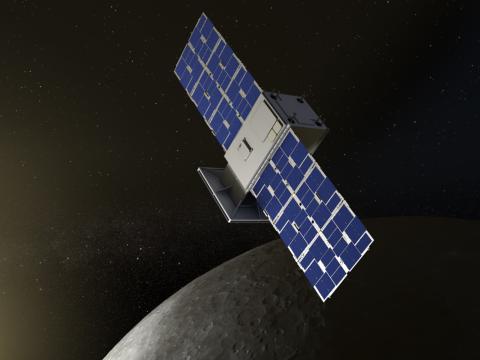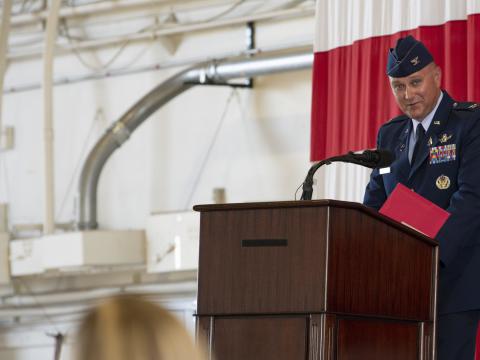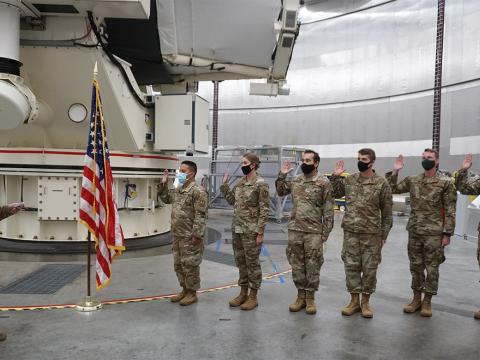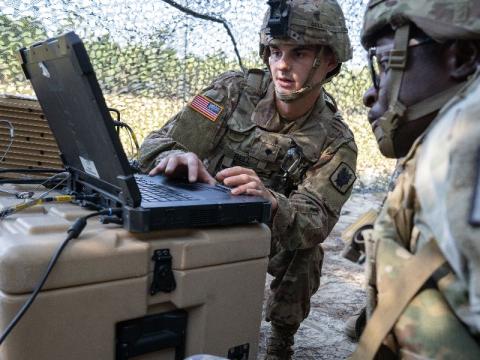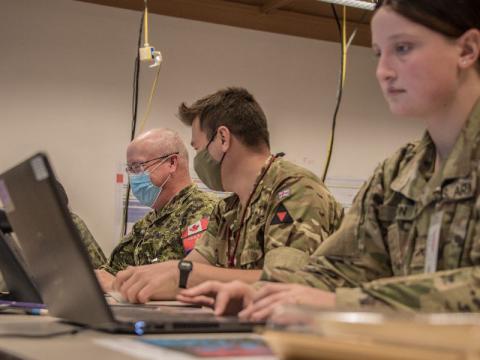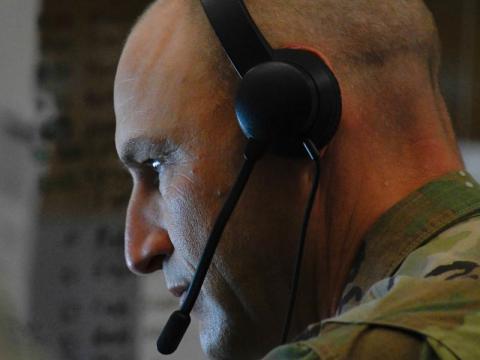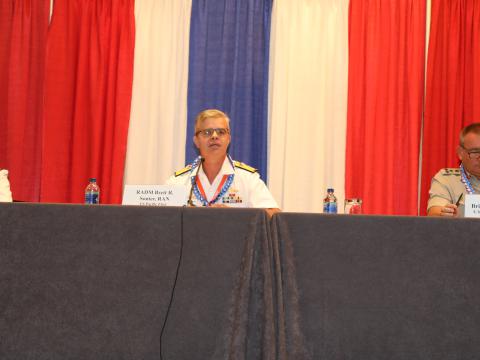Warfighters Connect Without Cables
Joint command development will reduce communications setup time and speed operational decisions. 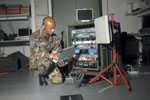
Master Sgt. Wayne O. Wright, USAF, works on the Wireless for the Warfighter (W4W) system at the Joint Systems Integration Command located at the U.S. Joint Forces Command’s Suffolk, Virginia, complex. W4W brings both classified and unclassified wireless networking capabilities to the deployed environment.
The
The U.S. Joint Forces Command’s (JFCOM’s) Joint Systems Integration Command (JSIC),
The U.S. Northern Command’s Joint Task Force Civil Support (JTF-CS) will be the first organization to receive and use the technology, though officials there say the capability has application and future uses for troops deployed overseas as well. One JTF-CS mission is to establish communications and command and control in an area of responsibility within 12 hours of being called in. It often takes the task force that amount of time to wire and connect all relevant personnel. James Bohling, W4W project lead at JFCOM, says the capability will establish all the necessary communications within four hours.
Voice and data are provided over the wireless network, and the W4W kits include softphones—telephones that communicate via the Internet—instead of the traditional desktop telephones. The voice over Internet protocol capability eliminates the need for separate voice and data wires, and reducing the logistical footprint is a key criterion of success for the program.
According to Bohling, the kits are mostly a combination of hardware with some integrated services. JSIC is taking various components such as switches and routers and combining them into the fewest possible devices. The W4W baseline comprises commercial technology, but developers are working with some government off-the-shelf products that are in development for possible use in the near future. Bohling explains that his team integrated the various technologies to provide the capabilities customers need including wireless and modular features. He adds that the W4W can provide a wired network, too.
The baseline W4W solution is designed to provide service for 65 to 100 personnel and can provide connectivity for more staff members by integrating additional components. According to Bohling, the minimal amount of equipment necessary to create the system coupled with its quick establishment time line makes it valuable for JTF-CS chemical, biological, radiological, nuclear and high-yield explosive incident-response situations.
The JTF-CS already has received the 802.11 wireless local area network piece of the W4W and will receive the 802.16 capability in May or June. The 802.16 component will enable troops to position their land services a significant distance away from a smaller deployed element. Lt. Col. Curtis Fox,
Bohling explains that the JFCOM developers are in the process of integrating classified wireless and broadband wireless access into the W4W. In its current state, the technology has a secure, unclassified local area network. The next step is to provide a classified local area network and unclassified metropolitan area network.
Bohling states that JTF-CS members mainly remain in one location, and communications are built to connect the static troops. With the local area network capability, the service members will have the freedom to move with their communications. The technology is analogous to cell phone use. Cell phone users can travel to various locations without losing the ability to communicate. The W4W will provide similar capabilities, but over a more limited area. Bohling says developers envision a five-mile bubble of data access.
All components are housed and transported in 10- to 12-unit transit cases. The W4W kits contain various technologies including enterprise, carrier class and Internet service provider (ISP). The U.S. Defense Department or a particular unit would be the service provider instead of requiring troops to obtain a separate provider.
Bohling explains that the wireless network will result in a drastic reduction in the logistical footprint and logistics planning as well as reduce airlift requirement and near-deployment times. Troops will have the ability to move in and implement communications faster because they no longer need to lay all the cables and devices.
Setup of all the devices can be manpower intensive for JTF-CS communications personnel. When the task force deploys to an incident site, its personnel take command of all Defense Department assets. The key to military success, according to Col. Fox is timely and efficient command and control, and the J-6 staff supports that expediency through heavy, medium and small communications packages that use legacy technology. Personnel require varying amounts of time to set up and complete phone cabling for the different packages, and they wire for the nonsecure Internet protocol router network (NIPRNET) and secret Internet protocol router network (SIPRNET). The JTF-CS J-6 will use the W4W with the heavy communication packages, which include enough equipment to support several hundred users. At that point, J-6 personnel benefit from establishing wireless technology because of the shortened time line. With the smaller packages, the wiring takes less time and the wireless capability provides fewer advantages.
 |
| The W4W capability will allow troops in incident-response situations to be operational sooner. Leaders will have access to more timely pictures of scenarios and could relay orders more quickly. |
The W4W also gives JTF-CS troops flexibility and scalability—important factors in incident response scenarios. JTF-CS personnel could deploy to various locations such as a six-story building or an unfinished warehouse. With legacy tools, J-6 troops must run cabling to 200 to 300 people in those buildings. With wireless capabilities, they set up only a few access points, allowing missions to be operational more quickly. “What’s critical about that is part of our response is to restore trust and confidence in our military and our military’s ability to support our citizens,” Col. Fox states. The sooner troops are operational, the faster they can improve situations.
Col. Fox emphasizes that the W4W is for all of the military. “[JFCOM JSIC is] not building JTF-CS’ system,” he shares. “They’re building a capability that can be fielded through the Defense Department. We’re just the guinea pigs.” The W4W will allow
The W4W also provides other benefits to warfighters. Col. Fox explains that the JTF-CS has various legacy equipment that requires different skill sets. Many of the personnel who work with the task force do not have the skill sets needed to use this equipment. By moving toward a wireless environment and running services over an Internet protocol (IP) architecture, Col. Fox will not have to train personnel in the skill sets required to operate legacy equipment, and the domino effect enables him to maximize training efforts into smaller groups of classes.
He states that although the military services are moving toward IP environments and some are moving toward wireless systems, transformation is slow. Having noncommissioned officers trained to use the capability at the JTF-CS allows Col. Fox to send the these troops back to other units with an understanding of this cutting-edge technology. “I categorize all that as taking care of troops,” he says.
First responders also could tap into the network, but both Bohling and Col. Fox stress that regulations and procedures, not technology, would prevent that from happening. From a technical standpoint, anyone could be granted access into the network, but the concept of operations will determine how the system is used and who uses it. While military troops could permit first responders to access the wireless network from a technology standpoint, information assurance rules and regulations still remain in place as a potential impediment.
Even without first responder network participation, JTF-CS troops will benefit from the faster establishment of command and control in an operations area. Commanders will be able to make decisions and relay orders more quickly. In addition to the W4W’s initial incident-response support, the technology also could aid in post-incident response and other command post operations.
JSIC is providing JTF-CS troops with training on the W4W and has set up test laboratories to perform testing in a controlled environment. The JTF-CS also is performing local exercises. These task force troops take a heavy communications package out to an armory and perform testing on the wireless network. The W4W has worked well with small groups, but users are still on a learning curve. During most monthly exercises, the JTF-CS tested the wireless network with 40 users. In December, the task force tried to network 80 users and overloaded the system, but Col. Fox shares that training and not technology was the key problem. Personnel had difficulty with channeling, and all the user signals were routing through one access point.
Col. Fox says implementation of the full W4W will be immediate, and he expects the JSIC to succeed in the development effort. The colonel plans to move forward with wireless systems and not fall back on systems that require more hardware. The W4W will allow the JTF-CS J-6 to maximize resources and provide services for troops downrange in deployed environments.
Web Resources
Joint Task Force Civil Support: www.jtfcs.northcom.mil
